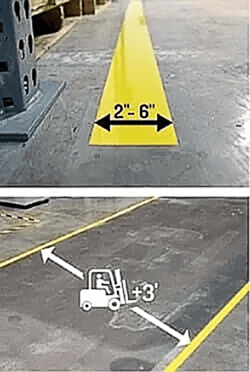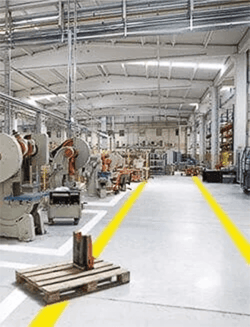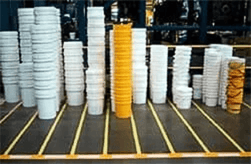OSHA Floor Marking Practices for a Safer and More Efficient Workplace

Modern workplaces, however safe they may be, are fraught with hazards. Forklifts, energized equipment, loading docks, busy warehouses, and other hazards can make it difficult for employees to work and move safely throughout a facility.
Floor marking for a factory is an essential component of a safe workplace. The floor lines, stripes, and dots lining facilities throughout the United States can create order, keep employees away from dangerous areas, and mitigate hazards wherever possible.
Here's a look at what OSHA has to say about floor marking, and how it can improve efficiency and increase safety in your facility.
OSHA Floor Marking Requirements
 At its core, floor marking consists of lines and symbols, most commonly painted or taped on a floor, that help people move around a facility and avoid hazards.
At its core, floor marking consists of lines and symbols, most commonly painted or taped on a floor, that help people move around a facility and avoid hazards.
OSHA addresses floor marking specifically in its standard on materials handling and storage (29 CFR 1910.176). There it states, "Permanent aisles and passageways shall be appropriately marked," though it offers few details or requirements.
To clear things up, OSHA has offered interpretations expanding on these OSHA floor marking requirements. Interpretations state that:
- Tape for floor lines must be at least 2" wide to ensure maximum visibility, though the agency recommends lines to be 2" to 6" wide.
- Aisles should be at least 4' wide, or at least 3' wider than the largest piece of equipment used in the aisle.
- OSHA allows facilities with unusual surfaces (including dirt floors) to use flags, traffic cones, barrels, and other similar methods as long as employees are trained on the system used.
OSHA Floor Marking Color Requirements
There are no OSHA floor marking requirements for specific floor marking colors; however, a 1972 OSHA interpretation states that lines meant to define aisles may be any color, provided they lay out the aisle.
That said, the agency's standard for safety color codes (29 CFR 1910.144) can act as an OSHA floor marking guide for establishing a color-coded floor marking system. It specifies that red and yellow must be used for marking physical hazards.
- Red floor tape identifies fire-related hazards (including fire protection equipment and containers of flammable liquids), as well as emergency switches, bars, and buttons on hazardous machines.
- Yellow floor tape signals caution and marks physical hazards (including striking against, stumbling, falling, tripping, and "caught in between").
- Note: This does not mean standard safety floor tape can't or shouldn't be yellow; OSHA said, in a 1977 interpretation, that "yellow lines are usually recognized as the most convenient and inexpensive way to mark aisles and passageways."
Beyond these requirements, employers are free to use whichever colors they see fit for floor marking, provided they use the same colors consistently throughout a facility.
Mitigating Hazards with OSHA Floor Marking
 Now that you know the basics, how can hazard floor marking tape protect employees? Here's a quick rundown:
Now that you know the basics, how can hazard floor marking tape protect employees? Here's a quick rundown:
- Separate workers from machines and moving equipment: Use floor marking tape to designate paths that protect pedestrians from forklifts, electrical panels, heavy machinery, and other hazards.
- Warn of hazardous areas: Keep employees safe on loading docks around dangerous equipment and around areas with exposed edges.
- Provide instruction: Let employees know where to stand (or where to avoid) when operating heavy machinery and other equipment.
- Improve forklift safety: Forklifts are fraught with hazards. Safety floor tape can establish pedestrian-only walkway lines, keep employees away from imbalanced or unsafe loads, and establish traffic controls for drivers. Learn more about forklift safety tips.
- Keep employees safe in low-light conditions: Phosphorescent floor marking can help employees find exits and equipment in emergencies and other low-light situations.
Improving Organization with OSHA Floor Marking
 Floor marking isn't just a great tool for mitigating hazards and improving safety; it can also improve organization and efficiency. Here's how:
Floor marking isn't just a great tool for mitigating hazards and improving safety; it can also improve organization and efficiency. Here's how:
- Establish traffic routes: Establish aisles for pedestrians and vehicles and direct the flow of traffic; doing so can help employees get where they're going in a safe, efficient manner.
- Use 5S tape in your lean system: The 5S system aims to improve efficiency, increase organization, and reduce waste-all of which can be facilitated through 5S floor tape. See how symbols, text, and floor marking tape can complement your 5S system.
- Designate storage areas: Floor marking tape can cordon off areas meant for inventory, PPE, hazardous equipment, forklifts, and other items.
DuraLabel Floor Marking Resources
Using the right 5S floor tape is paramount when creating a safe warehouse. That's why it's recommended to use DuraLabel PathFinder RIGID™ Floor Marking Tape. This heavy-duty caution floor tape can withstand intense equipment traffic while protecting pedestrians and vehicles in motion.
DuraLabel's Floor Marking Instant Action Guide helps you get started with floor marking. The free guide helps readers understand the appropriate regulations and standards, improve safety and efficiency, and choose the best floor marking method. Request your free Floor Marking Instant Action Guide today.
Learn more about floor marking with this quick overview of common floor signage colors from the DuraLabel Floor Marking Color Chart. The free, one-page guide explains common industry practices, specific uses for various colors, and the importance of color coding throughout a facility. Grab a Floor Marking Color Chart today.
Read Next:
Related Resources

A Quick Guide to Floor Marking Products
Why are Floor Marking Solutions Important? Floor marking solutions help safety managers and facility teams ...
Read
Tips for Choosing the Optimal Floor Marking Tape
Identify Goals For Floor Marking What is the best floor marking tape for different environments? The best ...
Read
Why OSHA Required Floor Marking Fails in Summer
Why Does Floor Marking Tape Fail More Often in Summer? Floor marking tape fails more frequently in summer ...
Read.png)





